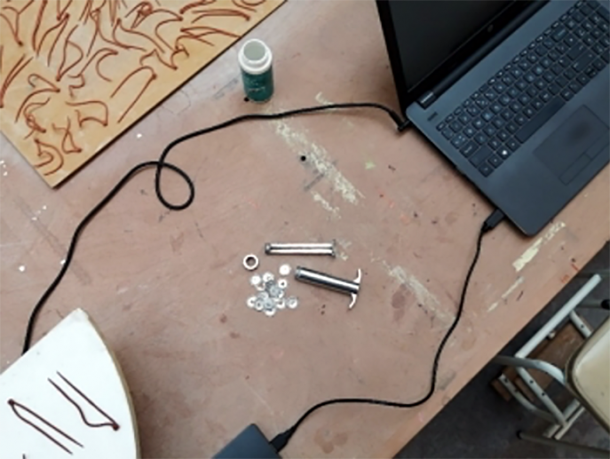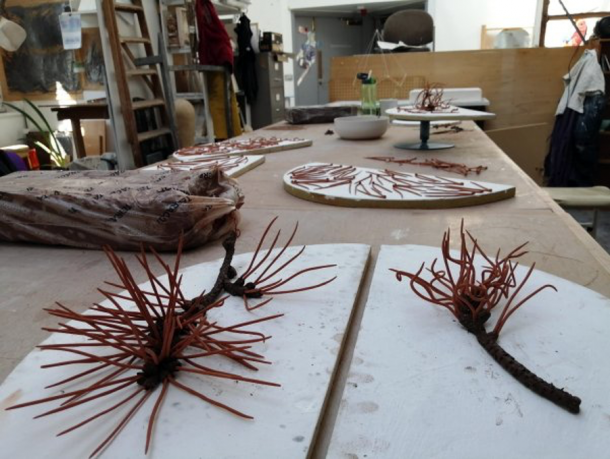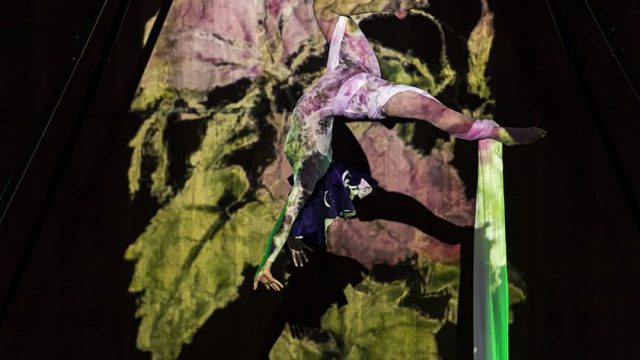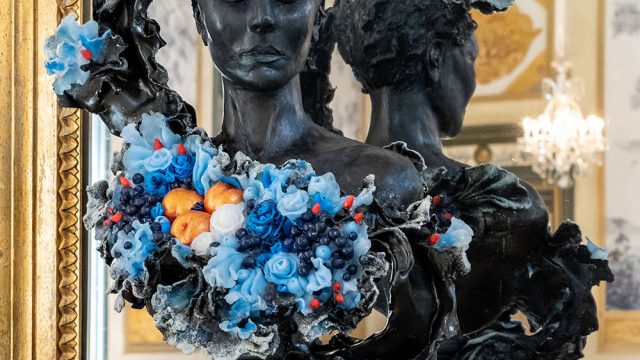Artists need space and time to be alone, at times to be isolated. I find it impossible to think or follow through with an idea if I have too much outside stimulus. But time alone is usually a choice, a chance for artists to step aside and see the world obliquely. Being forced to take this time is different, I’ll attempt to explain how … luckily for me I can temporarily use my studio space (previously being sublet while resident at the V&A) in my hometown of Stroud. Here, alone in this space, I am isolated from the Covid-19 virus, anyone who is carrying it, isolated from the news, conspiracy theories, slow governments and anything else that makes me recoil. I am isolated from my loved ones here, and away from my new role as teacher in a home education routine. In this familiar studio space but without my friends, I often feel as if I’m living a dream, one from which I might wake up. Or worse still, maybe my residency at the V&A was a dream?
Isolation, for me, requires the setting of minute individual structures and deadlines. After the initial shock of the speed of the lockdown, from rumour to actuality on 23 March, I felt my focus disappear into the weeks ahead. With no pressure of deadlines, meetings, critics and plans for workshops, I have been left stranded, in hiatus and not – as some might imagine – liberated. Isolation is delicious with the knowledge that at some point it will all end. Usually there is a date in mind or on the calendar when the ‘time and space alone’ will end, creating a moment in time that will be productive in its restorative mission. But to remain isolated ‘for the foreseeable future’ is a trap. I miss people. The V&A residency is so public; the studio itself has glass walls for strangers to look in and I miss their visual questions.
The last few days at the V&A were a panicked rush to produce an installation inside my studio space that I had been planning for months. More to come on this and a fuller report at the end of my residency, but here is a taster image below. The installation is entitled ‘Repository – The Final Resting Place’ and it is an attempt to make tangible the engineering process and use of copper and bentonite clay for the final burial of spent nuclear fuel, deep underground. The installation was meant to be for opening and public viewing on 27 March. It remains unseen, as does the entire contents of the V&A.
It is eerie to think of this.

There are comparisons between the unseen virus and contaminating radionuclides. Although we cannot touch a stranger, and should wear gloves and masks in a supermarket, we can still be confident that our meat, fruit and veg is not contaminated. At the most some food stuffs require a soapy wash when we get home, but my thoughts are with those that could not and still cannot, fully trust the safety of their local produce due to radiation contamination.
It’s been a gloriously sunny few weeks in Britain during lockdown, thank goodness. Now the heavy rain pelts down on the roof of my thoughts, I am grateful for the garden’s sake. But think of those organisms washed in fall-out rain, heavy radioactive particles from the atmosphere running into leaf stomata, soils and rivers, soaked up by plant life and consumed by cattle and in turn, your children’s bedtime milk? Let’s not forget, this could happen again, as a viral pandemic will certainly happen if our governments choose to react too slowly again. Have any lessons been learned?
On the last few days in my V&A space, I had a few hours to choose all the books and materials I would need (in an emergency, what would you take?). I had the intention of returning the week after but, with the knowledge this was not likely to happen, I managed to pack one tool into my overnight bag as I left London a few days before lockdown.

This tool, a little metal hand extruder has been used to commence a piece of work that will hopefully be later installed in the base of the vitrine next to my studio. This new piece of work has kept me focused in isolation.
My research has led me to the curious ‘Cancellation of apical dominance’ in pine trees such as Pinus sylvestris (Scots pine) in Chernobyl and Pinus densiflora (Japanese red pine) in Fukushima. In young pines, there is much evidence of this strange morphological disturbance. I aim to accentuate these discoveries, producing an awkward but potentially attractive resulting branch. The unseen viruses, bacteria, organisms and radionuclides that surround us, remain at the heart of my working in isolation.




Hi Aimee – thanks for sharing those insights and images. It’s fascinating to know, and reflect on, even a small part of the mental and emotional processes – as well as technical skills – that artists like you apply. That’s even more apposite in this lockdown situation, when we crave (and gain much from) cultural stimulation like the V&A’s Residency programme. I’m keen to see your finished installation in due course, and I hope you find successful coping strategies when the isolation feels less positive.